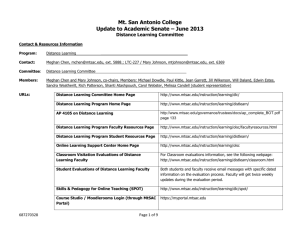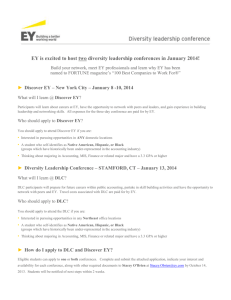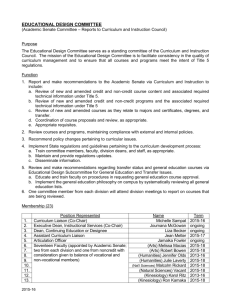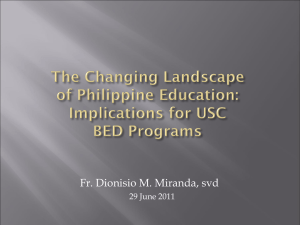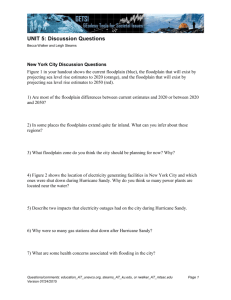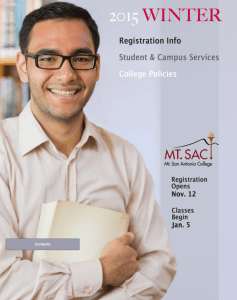Amendment Forms - Mt. San Antonio College
advertisement
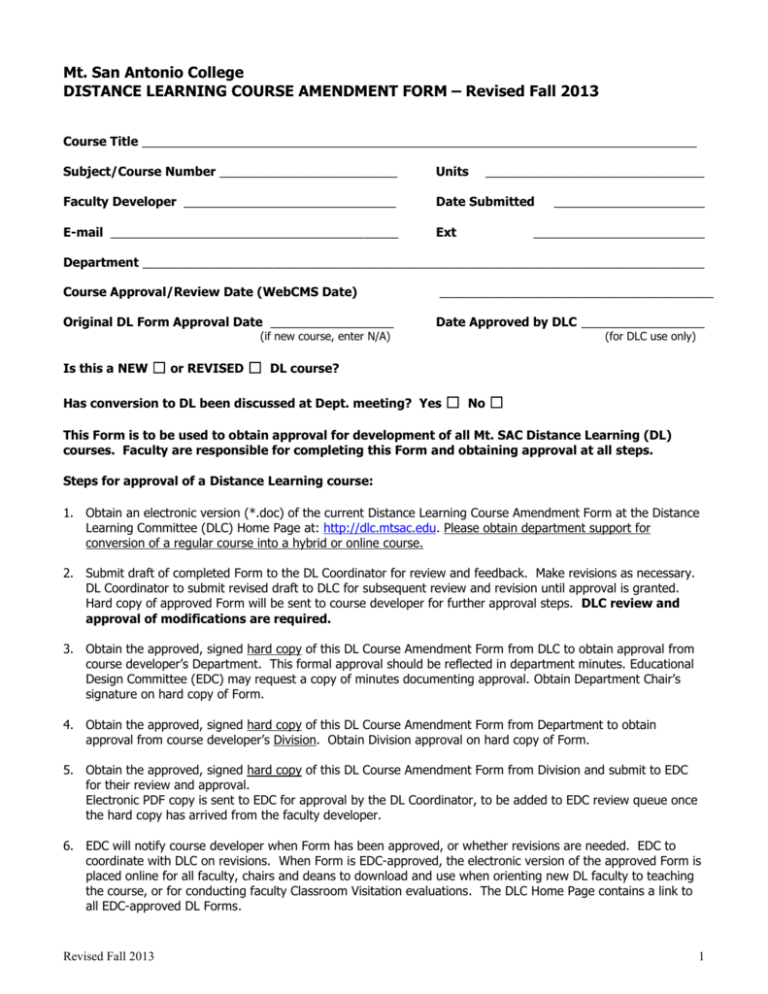
Mt. San Antonio College DISTANCE LEARNING COURSE AMENDMENT FORM – Revised Fall 2013 Course Title _________________________________________________________________________________ Subject/Course Number __________________________ Units ________________________________ Faculty Developer _______________________________ Date Submitted E-mail __________________________________________ Ext ______________________ _________________________ Department __________________________________________________________________________________ Course Approval/Review Date (WebCMS Date) ________________________________________ Original DL Form Approval Date __________________ Date Approved by DLC __________________ (if new course, enter N/A) (for DLC use only) Is this a NEW ☐ or REVISED ☐ DL course? Has conversion to DL been discussed at Dept. meeting? Yes ☐ No ☐ This Form is to be used to obtain approval for development of all Mt. SAC Distance Learning (DL) courses. Faculty are responsible for completing this Form and obtaining approval at all steps. Steps for approval of a Distance Learning course: 1. Obtain an electronic version (*.doc) of the current Distance Learning Course Amendment Form at the Distance Learning Committee (DLC) Home Page at: http://dlc.mtsac.edu. Please obtain department support for conversion of a regular course into a hybrid or online course. 2. Submit draft of completed Form to the DL Coordinator for review and feedback. Make revisions as necessary. DL Coordinator to submit revised draft to DLC for subsequent review and revision until approval is granted. Hard copy of approved Form will be sent to course developer for further approval steps. DLC review and approval of modifications are required. 3. Obtain the approved, signed hard copy of this DL Course Amendment Form from DLC to obtain approval from course developer’s Department. This formal approval should be reflected in department minutes. Educational Design Committee (EDC) may request a copy of minutes documenting approval. Obtain Department Chair’s signature on hard copy of Form. 4. Obtain the approved, signed hard copy of this DL Course Amendment Form from Department to obtain approval from course developer’s Division. Obtain Division approval on hard copy of Form. 5. Obtain the approved, signed hard copy of this DL Course Amendment Form from Division and submit to EDC for their review and approval. Electronic PDF copy is sent to EDC for approval by the DL Coordinator, to be added to EDC review queue once the hard copy has arrived from the faculty developer. 6. EDC will notify course developer when Form has been approved, or whether revisions are needed. EDC to coordinate with DLC on revisions. When Form is EDC-approved, the electronic version of the approved Form is placed online for all faculty, chairs and deans to download and use when orienting new DL faculty to teaching the course, or for conducting faculty Classroom Visitation evaluations. The DLC Home Page contains a link to all EDC-approved DL Forms. Revised Fall 2013 1 7. EDC submits courses to Academic Senate for approval and informs the DLC and Instruction Office. Special DL “designators” are placed on the course in Banner, for proper scheduling and assignment. Course Content: The rigor and content of a Distance Learning course must match the approved curricula (lecture topics and lab topics, measurable objectives) currently on file for that course in WebCMS. Obtain official course information by accessing WebCMS at http://webcms.mtsac.edu/webcms. Click on the Public Access link, enter the existing course subject and number, and click on the Search button. Then click on the course link created, in order to view your official course information. Last approved/reviewed date of course information must not be more than 4 years old, or all course information must be officially reviewed and approved by Department, Division, Educational Design Committee, and Academic Senate before DL course adaptation occurs. The faculty developer submitting this amendment and his/her Department faculty are responsible for reviewing the Distance Learning course content to see if the course outline and measurable objectives may be achieved in a Distance Learning mode. Official course outlines (lecture and lab, if applicable) are to be inserted in Table 2, Column 2 in this document. Mode(s) of Delivery: Mt. SAC supports two different modes of distance learning delivery - online and hybrid. Online courses have no required on-campus meetings and hybrid courses have required on-campus meetings. Approved distance learning courses may be offered in either mode, and must have all required meetings scheduled in Banner at time of faculty assignment, to appear in the Mt. SAC Schedule of Classes. Designing the DL Course: Mt. SAC’s distance learning courses are courses that have regularly scheduled replacement of seat time, are scheduled in Banner, and are published accordingly in the Mt. SAC Schedule of Classes. Distance learning courses are primarily delivered through the use of the College’s information system authenticated processes, which requires the use of a Mt. SAC-approved learning management system and Mt. SAC email. Other course delivery methods may be used for supplemental learning, but required course activities contributing to the course grade must be conducted using authenticated methods. All required distance learning course content and delivery methods must be accessible to all students, including those students with disabilities. A good design rule is to create course content using Universal Design Principles. If required audio and video course components are used in any course, they must be accessible. For information on Universal Design Principles or to obtain aid in developing accessible course materials, contact Disabled Students Programs and Services. Some course measurable objectives may not be feasible in the DL mode, and the developer may then plan for a hybrid delivery instead of a fully online delivery mode. The Distance Learning Faculty Coordinator can offer suggestions for the adaptation of traditional course components for online delivery. A well-developed DL course may include the following: Course outline – lecture and lab (if applicable) Learning objectives/outcomes (course measurable objectives, course SLOs) Syllabus o Course Reference Number (CRN), name and ID o Class times and locations o Schedule of activities (assignments and deadlines) o Professor contact information and office hours o Grading policy o Attendance/interaction policy o Make-up policy for missed work o Campus policies – add/drop, academic dishonesty, repeating courses o College’s policy on email usage (Mt. SAC email only) o Professor’s drop policy Frequently Asked Questions (FAQs) Revised Fall 2013 2 Student and professor expectations Good web design principles that address accessibility/accommodations for disabled students, especially with audio and video components A variety of web-based learning materials Discussion forum Interactive and relevant links to assignments or activities Content organized by themes or chunks of information (topics, chapters, weeks) Assessments DL Course Components and Delivery Methods: Title 5 Regulations, and the California Board of Governors for the California Community Colleges, require that course quality standards are met (same as applied to traditional courses) and that “regular, effective contact between the student and instructor” are included in the design of the course. In order to approve a course for DL delivery with attention to Title 5 regulations, it is necessary for the faculty developer of the DL course to describe each envisioned component and delivery method of the DL course. Please complete Table 1, being as descriptive and specific as possible about the Mechanics and Pedagogy envisioned for each component and delivery. For any online assignment that is in purely audio or video format, include information on the alternative learning modes that will also be available to disabled students. For each instruction method listed in the table, include: 1. unique abbreviation of the method (to be used later in Table 2 - Course Weekly Schedule of Activities). The following abbreviations are recommended for consistency: AN = Announcements AU = Audio components CM = Communication between Professor and students (office hours, email, phone, other) CO = Course Orientation (first contact by professor + orientation to DL course) DF = Discussion Forum EP = Essay papers EX = Exams F2F = on-campus classroom meetings/activities (for hybrid courses or course orientation meetings) GW = Group work HA = Homework assignments LA = Lab activities LEC = Lecture content delivery (written notes, PowerPoint presentations, outline) PA = Practice Assessments PM = Publisher’s provided materials QZ = Quizzes RP = Research papers or projects SG = Study guides or sessions TR = Textbook Readings VI = Video components Other 2-letter abbreviations may be used if not found on this list 2. how the method will work (Mechanics) how the method’s interaction is initiated (by professor or student) – give specifics of assignments, if necessary for clarification how the activity is conducted (by the student alone, with other students, or with the professor), and how submitted to the professor how feedback (grade or comments) are given to the student at the end of each activity 3. how the method will help students to learn the course material (Pedagogy) Table 1. DL Course Components and Delivery Methods Revised Fall 2013 3 Include methods that may be used by any faculty who teaches this course. Methods envisioned by the developer of the course do not prohibit the use of other methods by other faculty who may subsequently teach this DL course. Method Abbreviation Revised Fall 2013 Mechanics of Method/Activity (how does the method work?) Pedagogy of Method/Activity (how will students learn through this method?) 4 DL Course Weekly Schedule of Activities Complete the following table, by entering the official WebCMS information for this course, the current methods used in the traditional offering of this course, and use the abbreviations from Table 1 for the DL delivery of the course. Estimate a student’s time on task expected for each DL abbreviation activity listed. Include all of the students’ time needed for this course; consider the “college hour” (2 hours of homework for every lecture hour). Include both the “in-class” hours as well as the homework hours in this table. Table 2. DL Course Weekly Schedule of Activities All methods listed in Table 1 must be listed below. Use a 16-week format, even if shorter versions of the course are offered. Demonstrating “Regular and Effective Contact” in the course is required by state and federal regulations. 1 Week 2 Course Outline Lecture and/or Lab (from WebCMS) 3 Traditional Course (use brief descriptions) 4 DL Course (use abbreviations from Table 1) 5 Estimated time on task (hrs) 1 2 3 4 5 6 7 8 9 10 11 12 13 14 15 16 Revised Fall 2013 5 Teaching the DL Course: All faculty wishing to teach a DL course at Mt. SAC must complete the Skills and Pedagogy for Online Teaching (SPOT) distance learning certification process before being assigned to teach that course. Prerequisites for SPOT include completion of Basics training for LMS use and active use of Mt. SAC email. The SPOT process is facilitated during Fall and Spring semesters only. To learn more about SPOT, go to http://spot.mtsac.edu. For additional mentoring on DL course design and development, take a DL-related Professional & Organizational Development (POD) workshop or contact the Distance Learning Coordinator or Assistant Distance Learning Coordinator. Evaluations of DL Faculty Distance Learning faculty are evaluated using different evaluation forms than faculty teaching traditional courses. The evaluation forms to be used in evaluating DL faculty are: Student Evaluation of Distance Learning Faculty (Form H.2.e STUDENT - DL) Classroom Visitation of Distance Learning Faculty (Form H.4.c CLASSROOM - DL) Consult the current Faculty Agreement (contract) for these evaluation forms. Consult Distance Learning Committee web site (http://www.mtsac.edu/dlc/) for details on these evaluation processes. Resources for DL Faculty and Students Campus resources that are available for Distance Learning faculty and students are: Distance Learning/Online Learning Support Center faculty support: Distance Learning Program website – http://www.mtsac.edu/instruction/learning/distlearn/ Dean, Library & Learning Resources – Meghan Chen, x5658, mchen@mtsac.edu Online Learning Resource Center (OLSC) - Bldg 6-262 – http://olsc.mtsac.edu/ Distance Learning Coordinator – Bldg 6-262 Assistant Distance Learning Coordinator – Bldg 6-262 Distance Learning/Electronic Reference Librarian – Bldg 6-228, Paul Kittle, x4258, pkittle@mtsac.edu Teaching & Learning Technology Specialist - Carol Webster, x5016, cwebster@mtsac.edu IT Help Desk – 909-274-4357 or HelpDesk@mtsac.edu Faculty development resources: Professional & Organizational Development (POD) for learning management system training – http://pod.mtsac.edu MR Community course – https://mtsac.mrooms.net/course/view.php?id=15 Skills & Pedagogy for Online Teaching (SPOT) – http://spot.mtsac.edu Student resources: Inclusion of student resources in DL courses (e.g., in syllabus, within learning management systems) shows our college’s compliance with accreditation standards that require colleges to provide comparable student support services to students taking distance learning courses. Disabled Students Program & Services - http://dsps.mtsac.edu Online Counseling - https://my.mtsac.edu/OnlineCounseling/Welcome.aspx Online Learning Readiness Surveys – http://www.mtsac.edu/distancelearning/quiz/ Mt. SAC Library – http://library.mtsac.edu Learning Assistance Center – http://lac.mtsac.edu o Tutorial Services – http://ts.mtsac.edu Online Tutoring http://www.mtsac.edu/instruction/learning/lac/online-tutoring.html o Testing Center – Learning Assistance Center, Bldg 6 lower level Placement Tests (English, Reading, Math, Chemistry) – Student Services Building, Bldg 9B http://www.mtsac.edu/assessment/ Revised Fall 2013 6 DISTANCE LEARNING COURSE AMENDMENT FORM Verification of Approval The following steps must be approved and signed in this order. It is the developer’s responsibility to obtain an approval signature at each step of this process. Any questions, contact Meghan Chen, x5658. Course: _________ 1. Distance Learning Committee DLC Co-chair Signature:_______________________________________ Date__________________ DLC Co-chair, Dean, Library and Learning Resources Signature:_________________________________________________ Date__________________ 2. Faculty Developer Note to Developer: Faculty must complete SPOT certification process before being assigned to teach a DL course. SPOT process is facilitated during Fall and Spring semesters only. Developer understands that the content, rigor, interaction, authentication and accessibility of the DL course must adhere to various regulations in the development and delivery of the DL course. Faculty Developer Signature:___________________________________ Date__________________ 3. Department Note to Department Chairs: Faculty must complete SPOT certification process before being assigned to teach a DL course. SPOT process is facilitated during Fall and Spring semesters only. To check faculty eligibility to teach a DL course or to view Forms of approved DL courses, go to the DLC Home Page at http://www.mtsac.edu/dlc/. and click on the Approved DL Courses link for a list of approved courses or DL Faculty link for a list of current approved DL faculty. Chair Signature(s)___________________________________________ Date__________________ 4. Division Note to Division Deans: Faculty must complete SPOT certification process before being assigned to teach a DL course. SPOT process is facilitated during Fall and Spring semesters only. To check faculty eligibility to teach a DL course or to view Forms of approved DL courses, go to the DLC Home page at: http://www.mtsac.edu/dlc/ and click on Approved Courses link for a list of approved courses or DL Faculty link for a list of current approved DL faculty. Division Signature__________________________________________ Date__________________ 5. Educational Design Committee Note to EDC: Any modifications to this Form must be coordinated with the DLC. Notify DLC when this Form has been approved. See the DLC-initiated recommendation Distance Learning Committee Recommendation Procedure for Re-evaluating DL Modification Forms for information on when a DL Form should be reviewed. EDC Co-Chair Signature_______________________________________ Date__________________ 6. Date Received in Instruction Office ______________________ Revised Fall 2013 7
